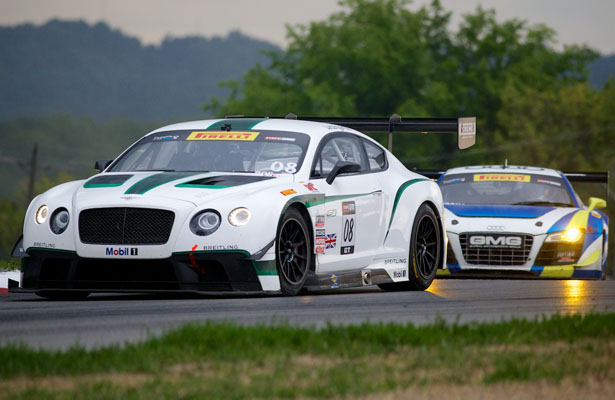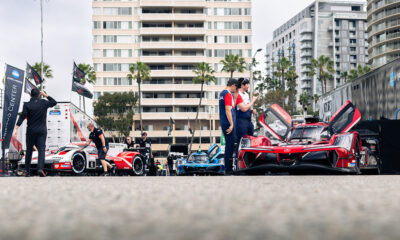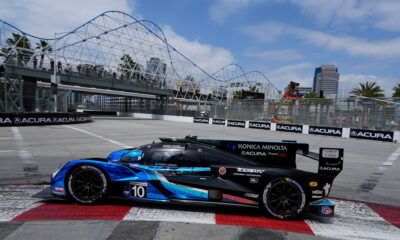
Photo: John Dagys
The future of the TUDOR United SportsCar Championship became clearer last week, as IMSA confirmed the class structure for the next two years, while also providing a glimpse into 2017 and beyond.
While stability is the key word in the short-term, with no changes to the current four-class structure in 2015, the GT categories are set for an overhaul in 2016, with new regulations set to be introduced for the Prototype class one year later.
Arguably the biggest change in the production-based ranks is the arrival of full FIA GT3-spec machinery to the GT Daytona class, a move that will see all of the current GT3-based cars run with complete aerodynamic packages and driver aids originally built into each model.
According to Scot Elkins, IMSA’s Vice President of Competition and Technical Regulations, the decision to fully embrace the FIA GT3 platform came shortly after talks to create a new common set of GT regulations for 2016 broke down earlier this year.
“It started with the GT non-convergence,” Elkins told Sportscar365. “When that didn’t happen, it reset some things for a number of manufacturers and put us in a position. We like to take conservative approaches to things and not dive in and that was part of the process.
“We worked as a group with everybody, and are still working as a group, to define performance targets for GTE and GT3 cars. By doing that, it helps us put those together and race together.”
While unrestricted GT3 cars, as seen in championships such as the Blancpain Endurance Series and Pirelli World Challenge, are often times quicker than GTE machinery, Elkins said that will change in 2016 when new regulations are adopted for the GTE platform.
Details on the GTE overhaul have yet to be finalized by the FIA and ACO, although it’s understood the cars will feature a slight horsepower boost, which will help separate the two categories,
“Our ability to sit on the technical working groups, to be a part of GT convergence, to have all of that information, is what helped us make the decision,” Elkins said.
“By also going through the list of who’s having a new car for ’16, it fills up your hand. It makes this decision make even more sense.”
Elkins said he doesn’t expect any significant issues for current GTD teams to make the transition for 2016. The majority of the GT3-based cars on the grid today will be legal with minor modifications, such as re-enabling traction control and ABS, as well as reverting to the car’s standard aero package.
A handful of teams actually took delivery of their cars in FIA GT3 specification, while the ones that didn’t will need to spend an estimated $30,000 to $40,000 in upgrades, according to one GTD team manager.
The only current GTD car caught out is the Porsche 911 GT America, which was specifically built for TUDOR Championship competition, although it’s understood Porsche is already starting work on a new 991-based GT3 R that would be ready for 2016.
“Some of the cars that are racing with us now had to undergo massive changes back in the GRAND-AM days,” Elkins said. “The guys that have joined us since then haven’t.
“It’s oversimplified to say it’s just driver aids and a rear wing but that’s all it really is. We haven’t made anybody change roll cages or change massive aerodynamics.
“I don’t think it’s really that big of a change. With one more year [of eligibility], we’re staying consistent with the guys that have signed up with us the first year.”
On the prototype front, the regulations for the Prototype Challenge class has been extended by an additional year, despite initial threats of the category’s elimination at the end of next year.
As a result, the Oreca FLM09s have gained a new lease on life, at least through 2016.
“We put the PC teams in a little bit of a difficult position this year,” Elkins admitted. “But everything was so new and we were trying to make things work.
“We were able to make a few changes going into ’15 and really put those guys in a better place. “Announcing the extension, it gives us a stable platform so we can start working on that ’17 prototype and make a decision how that’s going to play out.”
Elkins said IMSA remains committed to delivering a Pro-Am prototype component beyond 2016 and is currently evaluating multiple options, including the possibility of utilizing the same new-for-2017 Prototype class regulations in PC as well.
“Will it be the same car for Pro class and Pro-Am class? Do we keep using the PC car as the Pro-Am prototype? Do we look at LMP3?
“There’s all of these things that are out there,” he said. “It gives us the time to make a good decision and plan ahead and to make sure everyone’s in a good place when ’17 comes around.
“We’re just at the beginning of the process with the new [Prototype class] car. We’re having our first meeting at the end of September with the worldwide group. Until we work through that, we just need to evaluate everything and keep our ear to the ground.”
























